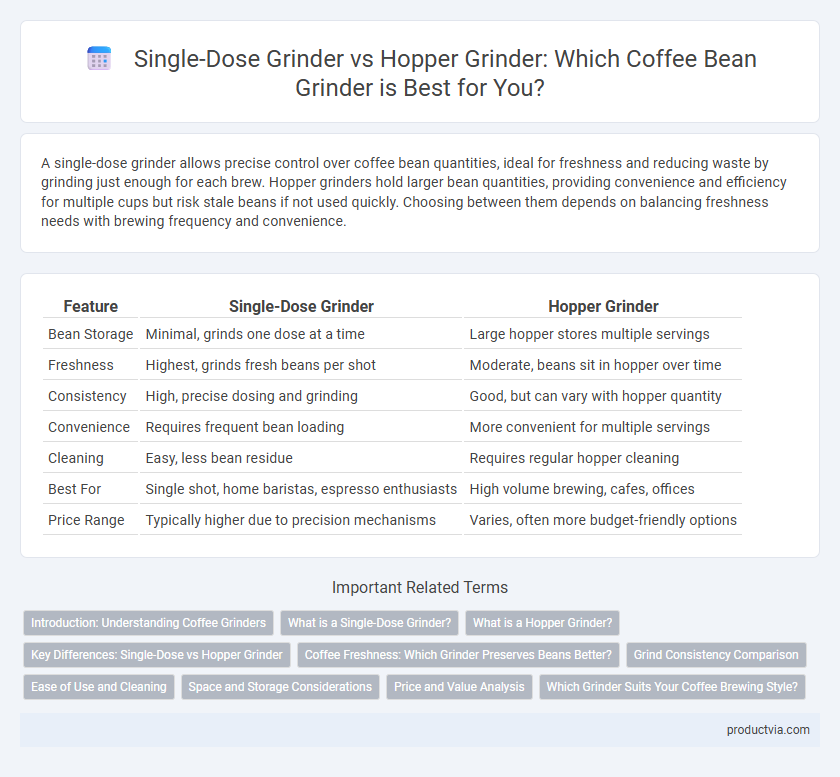A single-dose grinder allows precise control over coffee bean quantities, ideal for freshness and reducing waste by grinding just enough for each brew. Hopper grinders hold larger bean quantities, providing convenience and efficiency for multiple cups but risk stale beans if not used quickly. Choosing between them depends on balancing freshness needs with brewing frequency and convenience.
Table of Comparison
| Feature | Single-Dose Grinder | Hopper Grinder |
|---|---|---|
| Bean Storage | Minimal, grinds one dose at a time | Large hopper stores multiple servings |
| Freshness | Highest, grinds fresh beans per shot | Moderate, beans sit in hopper over time |
| Consistency | High, precise dosing and grinding | Good, but can vary with hopper quantity |
| Convenience | Requires frequent bean loading | More convenient for multiple servings |
| Cleaning | Easy, less bean residue | Requires regular hopper cleaning |
| Best For | Single shot, home baristas, espresso enthusiasts | High volume brewing, cafes, offices |
| Price Range | Typically higher due to precision mechanisms | Varies, often more budget-friendly options |
Introduction: Understanding Coffee Grinders
Single-dose grinders are designed to grind coffee beans one batch at a time, offering precise control over freshness and portion size, ideal for specialty coffee enthusiasts. Hopper grinders store larger quantities of beans in a container, allowing for continuous grinding and convenience in high-volume settings like cafes. Choosing between them depends on brewing preferences, with single-dose models emphasizing bean preservation and hopper grinders prioritizing efficiency.
What is a Single-Dose Grinder?
A single-dose grinder is designed to grind coffee beans one batch at a time, allowing users to weigh and grind the exact amount needed for a single brew without storing excess beans in a hopper. This grinder type minimizes bean degradation and preserves freshness by reducing the exposure to air, moisture, and light. Ideal for coffee enthusiasts seeking precise control over each dose, single-dose grinders enhance flavor consistency for every cup.
What is a Hopper Grinder?
A hopper grinder features a built-in container, or hopper, that holds a large quantity of coffee beans, allowing for continuous grinding without the need for frequent refills. This design is ideal for high-volume settings or those who prefer to grind multiple servings at once. Hopper grinders offer convenience and efficiency compared to single-dose grinders, which require manual bean measurement for each grind.
Key Differences: Single-Dose vs Hopper Grinder
Single-dose grinders are designed to grind coffee beans per individual use, ensuring maximum freshness and minimal waste, while hopper grinders store larger quantities of beans for continuous grinding, suitable for high-volume needs. Single-dose grinders typically offer precise dosing control and reduce the risk of stale beans, whereas hopper grinders prioritize convenience and efficiency with bulk storage and faster grinding capacity. Choosing between them depends on consumption patterns, with single-dose grinders favored by espresso enthusiasts who value freshness, and hopper grinders preferred in busy cafes requiring rapid output.
Coffee Freshness: Which Grinder Preserves Beans Better?
Single-dose grinders offer superior coffee freshness by grinding beans immediately before brewing, minimizing exposure to air and preventing oxidation. Hopper grinders store larger quantities of beans in a container, causing prolonged contact with oxygen that accelerates staling and flavor degradation. For maintaining optimal bean freshness and peak coffee flavor, single-dose grinders are generally the better choice.
Grind Consistency Comparison
Single-dose grinders provide precise grind consistency by grinding small, fresh batches of coffee beans without residual buildup, ensuring flavor purity. Hopper grinders, while convenient for larger quantities, may suffer from uneven grind due to bean variability and static retention in the hopper. Single-dose models excel in reducing grind size variation, critical for espresso and specialty brews requiring exact particle distribution.
Ease of Use and Cleaning
Single-dose grinders simplify the coffee-making process by allowing precise measurement for each brew, minimizing coffee waste and making cleanup quicker due to fewer beans in the chamber. Hopper grinders store larger quantities, offering convenience for multiple servings but require more frequent cleaning to avoid stale bean buildup and oils. Ease of use favors single-dose grinders for those valuing quick cleanup and accuracy, while hopper grinders suit users prioritizing capacity over maintenance frequency.
Space and Storage Considerations
Single-dose grinders require minimal counter space and eliminate the need for bean storage, making them ideal for compact kitchens or limited storage areas. Hopper grinders feature larger bean reservoirs that occupy more space but provide continuous grinding without frequent refills, suitable for high-volume coffee brewing. Choosing between single-dose and hopper grinders depends on available kitchen space and the preferred convenience of bean storage versus space efficiency.
Price and Value Analysis
Single-dose grinders typically offer precise grinding for small batches, appealing to coffee enthusiasts seeking consistency with minimal bean waste, often priced higher due to specialized design and build quality. Hopper grinders accommodate larger quantities, providing convenience for frequent brewing but sometimes compromising grind uniformity, generally available at a lower cost and delivering better value for volume consumption. Evaluating price against user needs, single-dose grinders suit those valuing precision and freshness, while hopper grinders offer cost-effective versatility for everyday use.
Which Grinder Suits Your Coffee Brewing Style?
Single-dose grinders provide precise control over coffee bean quantity, ideal for those who prefer brewing single cups with freshly ground beans, minimizing oxidation and preserving flavor. Hopper grinders suit users who brew multiple cups or batches, offering convenience and consistent grinding for higher volume use. Choosing between them depends on your brewing frequency and preference for freshness versus efficiency.
Single-dose grinder vs Hopper grinder for coffee beans Infographic

 productvia.com
productvia.com